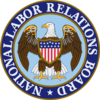NLRB case production in FY 2011: Significant decisions and public engagement in a productive year
Office of Public Affairs
202-273-1991
publicinfo@nlrb.gov
www.nlrb.gov
The National Labor Relations Board issued 368 decisions in contested cases during Fiscal Year 2011 (October 1, 2010 through September 30, 2011) while also pursuing two rulemaking initiatives and seeking increased public engagement.
The year-end numbers, which include 272 unfair labor practice cases and 96 representation cases, represent an increase of 17% over the previous year. The number of pending cases at the end of the fiscal year dropped from 236 in the previous year to 209. Decisions addressed several difficult issues that had awaited Board guidance for years, such as the access rights of pro-union employees to employer property, the rights of undocumented immigrant workers to backpay remedies, and the protection of new collective bargaining relationships from challenge
Production was particularly high in August, the final month of the term of Chairman Wilma B. Liebman, who had served on the Board for nearly 14 years. A total of 81 decisions were issued that month. Output typically rises at the end of a term, when Board Members seek to finalize cases with which they are familiar.
The Board invited briefs from the public in five cases of significant interest, and sought public comment in two rulemaking proceedings – one regarding the posting of a notice of employee rights under the National Labor Relations Act, the other regarding proposed changes to pre- and post-election representation case procedures.
A final notice-posting rule was issued with some adjustments based on the 7,000 public comments received, and is scheduled to take effect on January 31, 2012. The proposed representation-case procedure rule drew more than 65,000 written comments and was also the subject of a two-day public hearing in July that featured more than 60 speakers and was webcast in its entirety. A final rule on this matter has not yet been issued.
On August 26, the Board unanimously denied a rulemaking petition filed in 2007 by Professor Charles Morris, which asked the Board to adopt a rule requiring employers in workplaces where a union did not already represent a majority of employees to bargain with a minority union with respect only to employees who were its members. Later, certain unions joined the petition. The Board determined that its resources were better allocated to case adjudication and pending rulemakings.
All Board decisions can be found on the Agency’s website here. Some highlights of case production in FY 2011 include:
- Two decisions (in UGL-UNICCO and Lamons Gasket) to protect new collective-bargaining relationships for a “reasonable period” to allow for bargaining– following a voluntary recognition agreement or a change in ownership of a unionized company, that overruled prior Board decisions in 2007 and 2002.
- A decision (in Specialty Healthcare) that Certified Nursing Assistants at a nursing home may comprise an appropriate bargaining unit without including cooks, janitors and other nonprofessional employees, which overruled a 1991 Board decision.
- A pair of decisions (in Kentucky River and J. Picini) adding daily compound interest to backpay and other monetary awards to remedy unfair labor practices , and requiring employers to post remedial notices electronically if they customarily communicate with employees that way.
- A decision (in New York, New York) that a casino unlawfully prohibited off-duty employees of a restaurant inside the casino from distributing handbills to customers on casino property, in support of their organizing efforts.
- A decision (in Dana Corp.) that an employer and union may lawfully establish a framework for future collective bargaining agreements prior to the employer’s recognition of the union.
- A finding (in Mezonos Bakery), based on an earlier Supreme Court decision, that undocumented immigrant workers are not entitled to backpay following unlawful dismissal even in cases where an employer knew of their status before hiring them.
- A finding (in Stericycle) that a union-financed lawsuit filed against an employer in the critical period just prior to an election is grounds for overturning the election.
- Issuance of new decisions in all but one of the remaining cases returned to the Board as the result of the Supreme Court decision in New Process Steel, which found that a two-member Board cannot act as a quorum.
Following several years of turnover and vacancies, Fiscal Year 2011 was a period of relative stability in terms of Board composition. The fiscal year began with four of the Board’s five seats filled, and continued that way until the expiration of Chairman Liebman’s term on August 27. The Board currently has three members.
“The increased productivity in the last fiscal year demonstrates the value of having a stable and functioning Board to process cases and resolve labor disputes, which is exactly what Congress intended by creating staggered terms for Members,” said NLRB Chairman Mark Gaston Pearce. “In the coming year, I hope we are able to continue providing this vital service to employers, unions, and above all, employees.”
###


